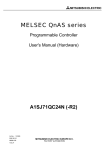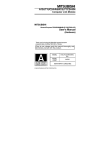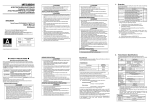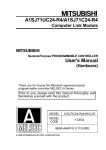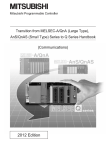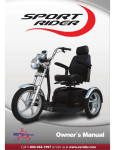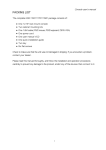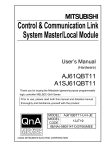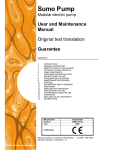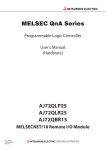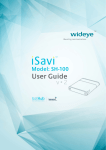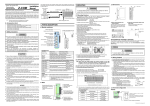Download Serial Communication Module User`s Manual (Hardware)
Transcript
Serial Communication
Module
User’s Manual
(Hardware)
A1SJ71QC24N1
A1SJ71QC24N1-R2
Thank you for buying the Mitsubishi general-purpose programmable
logic controller MELSEC-QnA Series
Prior to use, please read both this manual and detailed manual
thoroughly and familiarize yourself with the product.
MODEL A1SJ71QC24N1-U-HW
MODEL
13JP85
CODE
IB(NA)-0800330-B(1112)MEE
© 2005 MITSUBISHI ELECTRIC CORPORATION
SAFETY PRECAUTIONS
(Read these precautions before using this product.)
Before using this product, please read this manual and the relevant manuals
carefully and pay full attention to safety to handle the product correctly.
In this manual, the safety precautions are classified into two levels:
"
WARNING" and "
CAUTION".
WARNING
Indicates that incorrect handling may cause
hazardous conditions, resulting in death or severe
injury.
CAUTION
Indicates that incorrect handling may cause
hazardous conditions, resulting in minor or moderate
injury or property damage.
Under some circumstances, failure to observe the precautions given under
"
CAUTION" may lead to serious consequences.
Observe the precautions of both levels because they are important for personal
and system safety.
Make sure that the end users read this manual and then keep the manual in a safe
place for future reference.
A-1
[DESIGN PRECAUTIONS]
WARNING
When using the notification function, the pager receiver may not be
contacted due to the frequency transmission status from the system setup
environment and error on the receiver side.
To ensure the safety of the PLC system, install a call circuit with a lamp
display or buzzer sound.
When performing the control of the PLC in operation (especially changing
data, program, and operation status (remote run/stop)) by connecting a
personal computer, etc. to the special function module, configure an interlock
circuit in a sequence program so the safety of the overall system is always
maintained.
Especially, when this control is performed to a remote PLC from an external
device, troubles that have occurred on the PLC side may not be able to
immediately be handled if there is a data communication error.
Define a troubleshooting agreement between external devices and the PLC
CPU for data communication error occurrences, as well as construct an
interlock circuit in the sequence program.
[DESIGN PRECAUTIONS]
CAUTION
Do not bunch the control wires or communication cables with the main circuit
or power wires, or install them close to each other.
They should be installed 100mm (3.9 inch) or more from each other.
Not doing so could result in noise that would cause malfunction.
A-2
[INSTALLATION PRECAUTIONS]
CAUTION
Use the PLC in an environment that meets the general specifications
contained in the user's manual of the CPU module.
Using this PLC in an environment outside the range of the general
specifications could result in electric shock, fire, malfunction, and damage to
or deterioration of the product.
Be sure to shut off all phases of the external power supply used in the system
before installation or cleaning.
Failure to do so may cause an electric shock or damage to the product.
Insert the fixing projection on the module bottom into the fixing hole in the
base unit and mount the module using the hole as a supporting point. (For
the Q2AS series module, be sure to screw it to the base unit with the
specified torque.)
Incorrect module mounting may cause a malfunction, failure or drop of the
module.
Tighten the screws within the range of specified torque.
If the screws are loose, it may result in fallout, short circuits, or malfunction.
Tightening the screw too far may cause damage to the screw and/or the
module, resulting in fallout, short circuits, or malfunction.
Do not directly touch the module’s conductive parts or electronic
components.
Doing so could cause malfunction or failure in the module.
A-3
[WIRING PRECAUTIONS]
CAUTION
Be sure to fix communication cables leading from the module by placing
them in the duct or clamping them.
Cables not placed in the duct or without clamping may hang or shift, allowing
them to be accidentally pulled, which may result a module malfunction and
cable damage.
Perform correct pressure-displacement, crimp-contact or soldering for wire
connections using the tools specified by the manufactures.
Attach connectors to the module securely.
Before connecting the cables, check the type of interface to be connected.
Connection, or erroneous wiring, to the wrong interface may failure the
module and external devices.
Tighten the terminal screws within the range of specified torque.
If the terminal screws are loose, it may result in short circuits or malfunction.
Tightening the screw too far may cause damage to the screw and/or the
module, resulting in fallout, short circuits, or malfunction.
When detecting the communication cable from the module, do not pull the
cable portion.
For cables with connectors, hold the connector at the junction to the module,
then detach it.
For cables without connectors, first loosen the screw at the junction, then
detach the cable.
Pulling the cable portion while it is connected to the module may cause
malfunction or damage to the module and cable.
Be sure there are no foreign substances such as sawdust or wiring debris
inside the module.
Such debris could cause fires, failure, or malfunction.
A-4
[STARTING AND MAINTENANCE PRECAUTIONS]
WARNING
Do not touch the connector while the power is on.
Doing so could cause malfunction.
Be sure to shut off all phases of the external power supply used in the system
before cleaning or screw retightening.
Failure to do so may result in failure or malfunction of the module.
If the screw is too loose, it may cause an accidental drop of the module, short
circuit or malfunction.
Excessive screw tightening may cause damage to the screw and/or module,
resulting in a drop of the module, short circuit or malfunction.
[STARTING AND MAINTENANCE PRECAUTIONS]
CAUTION
Do not disassemble or modify the modules.
Doing so could cause failure, malfunction, injury, or fire.
Be sure to shut off all phases of the external power supply used in the system
before installing or removing the module.
Failure to do so may cause failure or malfunction of the module.
Always make sure to touch the grounded metal to discharge the electricity
charged in the body, etc., before touching the module.
Failure to do so may cause a failure or malfunctions of the module.
[OPERATING PRECAUTIONS]
WARNING
Do not write data into the "system area" of the buffer memory of special
function modules.
Also, do not output the "prohibited to use" signal as the output signal to a
special function module from the PLC CPU.
Writing data into the "system area" or outputting a signal for "prohibited to
use" may cause system malfunction in the PLC.
A-5
[OPERATING PRECAUTIONS]
CAUTION
Before performing the control of the PLC in operation (especially changing data,
program, and operation status (remote run/stop)) by connecting a personal
computer, etc. to the special function module, read this manual carefully and
confirm if the overall safety is maintained.
Failure to perform correct operations to change data, program, or the status
may result in system malfunction, machine damage, or an accident.
When using the module while values, such as buffer memory set values, are
registered in the EEPROM, do not turn off the power supply for the module
loading station not reset the PLC CPU.
If the power supply for the module loading station is turned off or the PLC
CPU is reset while any values are registered, the data contents in the
EEPROM become inconsistent and as a result the values must be set again
in the buffer memory, etc. and reregistered to the EEPROM.
Also, this may cause failure and malfunction of the module.
[DISPOSAL PRECAUTIONS]
CAUTION
When disposing of this product, treat it as industrial waste.
A-6
CONDITIONS OF USE FOR THE PRODUCT
(1) Mitsubishi programmable controller ("the PRODUCT") shall be used in
conditions;
i) where any problem, fault or failure occurring in the PRODUCT, if any,
shall not lead to any major or serious accident; and
ii) where the backup and fail-safe function are systematically or
automatically provided outside of the PRODUCT for the case of any
problem, fault or failure occurring in the PRODUCT.
(2) The PRODUCT has been designed and manufactured for the purpose of
being used in general industries.
MITSUBISHI SHALL HAVE NO RESPONSIBILITY OR LIABILITY
(INCLUDING, BUT NOT LIMITED TO ANY AND ALL RESPONSIBILITY
OR LIABILITY BASED ON CONTRACT, WARRANTY, TORT, PRODUCT
LIABILITY) FOR ANY INJURY OR DEATH TO PERSONS OR LOSS OR
DAMAGE TO PROPERTY CAUSED BY the PRODUCT THAT ARE
OPERATED OR USED IN APPLICATION NOT INTENDED OR
EXCLUDED BY INSTRUCTIONS, PRECAUTIONS, OR WARNING
CONTAINED IN MITSUBISHI'S USER, INSTRUCTION AND/OR SAFETY
MANUALS, TECHNICAL BULLETINS AND GUIDELINES FOR the
PRODUCT.
("Prohibited Application")
Prohibited Applications include, but not limited to, the use of the PRODUCT
in;
• Nuclear Power Plants and any other power plants operated by Power
companies, and/or any other cases in which the public could be
affected if any problem or fault occurs in the PRODUCT.
• Railway companies or Public service purposes, and/or any other cases
in which establishment of a special quality assurance system is
required by the Purchaser or End User.
• Aircraft or Aerospace, Medical applications, Train equipment, transport
equipment such as Elevator and Escalator, Incineration and Fuel
devices, Vehicles, Manned transportation, Equipment for Recreation
and Amusement, and Safety devices, handling of Nuclear or
Hazardous Materials or Chemicals, Mining and Drilling, and/or other
applications where there is a significant risk of injury to the public or
property.
A-7
Notwithstanding the above, restrictions Mitsubishi may in its sole discretion,
authorize use of the PRODUCT in one or more of the Prohibited
Applications, provided that the usage of the PRODUCT is limited only for
the specific applications agreed to by Mitsubishi and provided further that
no special quality assurance or fail-safe, redundant or other safety features
which exceed the general specifications of the PRODUCTs are required.
For details, please contact the Mitsubishi representative in your region.
A-8
REVISIONS
*The manual number is given on the bottom right of the cover.
Print Date
Dec., 2005
Dec., 2011
*Manual Number
IB(NA)-0800330-A
IB(NA)-0800330-B
Revision
First edition
Correction
COMPLIANCE WITH EMC AND LOW VOLTAGE
DIRECTIVES, Chapter 3, Section 5.1, 5.2,
Chapter 6
Addition
SAFETY PRECAUTIONS(Chinese), CONDITIONS
OF USE FOR THE PRODUCT
This manual confers no industrial property rights or any rights of any other kind, nor does it
confer any patent licenses. Mitsubishi electric Corporation cannot be held responsible for any
problems involving industrial property rights which may occur as a result of using the contents
noted in this manual.
© 2005 MITSUBISHI ELECTRIC CORPORATION
A-9
CONTENTS
1. Overview ........................................................................................................ 1
2. Transmission Specifications .......................................................................... 2
2.1 When the Modem Function is not Used ................................................... 2
2.2 When the Modem Function is Used ......................................................... 3
3. Part Names And Setting ................................................................................ 4
4. Mounting and Installation ............................................................................... 9
4.1 Handling Precautions ............................................................................... 9
4.2 Installation Environment ........................................................................... 9
5. External Wiring ............................................................................................. 10
5.1 Connecting RS-232C Line...................................................................... 10
5.2 Connecting RS-422/485 Line ................................................................. 13
6. External Dimensions .................................................................................... 18
A-10
ABOUT THE MANUALS
The following product are available for this equipment.
Refer to the table given below to choose suitable manuals.
Related Manuals
Manual name
Serial Communications Module Guidebook
Serial Communications Module User’s Manual
(Modem Function Additional Version)
Computer Link Guidebook
Computer Link Module (Com.link func./Print.func.)
User’s Manual
Manual No.
(Model code)
IB-66622
(13JF11)
IB-66612
(13J825)
SH-3510
(13JE76)
SH-3511
(13JE77)
COMPLIANCE WITH EMC AND LOW VOLTAGE DIRECTIVES
(1) Method of ensuring compliance
To ensure that Mitsubishi programmable controllers maintain EMC
and Low Voltage Directives when incorporated into other
machinery or equipment, certain measures may be necessary.
Please refer to one of the following manuals.
• User's manual for the CPU module used
• User's manual (hardware) for the CPU module or base unit
used
(2) Additional measures
To ensure that this product maintains EMC and Low Voltage
Directives, please refer to one of the manuals listed under (1).
A-11
1. Overview
This manual describes how to install the following serial
communications modules (hereinafter referred to as QC24N) and how
to wire them with external devices.
When unpacking the module, check that the products listed in the table
below are present.
Model
A1SJ71QC24N1
A1SJ71QC24N1-R2
*1
Product name
A1SJ71QC24N1 serial communication module
RS-422 communication terminal resistor
330Ω, 1/4W (orange/orange/brown/ )*1
RS-485 communication terminal resistor
110Ω, 1/2W (brown/brown/brown/ )*1
A1SJ71QC24N1-R2 serial communication module
How to discriminate between the terminating resistors
330
Orange
Orange
Brown
110
1
Brown
Brown
Brown
Quantity
1
2
2
1
2. Transmission Specifications
The transmission specifications of the QC24N is shown below.
Refer to CPU module User's Manual for QC24N general specification.
2.1 When the Modem Function is not Used
The table below lists the transmission specification when the QC24N
modem function is not used.
Specifications
A1SJ71QC24N1
A1SJ71QC24N1-R2
CH1
RS-232C
RS-232C
Interface
CH2
RS-422/485
RS-232C
Full-duplex/Half-duplex
Communications system
(Only RS-232C interface is selectable.)
Synchronous system
Asynchronous system
300, 600, 1200, 2400, 4800, 9600, 14400,
Transmission speed (Unit : bps)
19200, 28800, 38400, 57600, 115200
(The total of CH1 and CH2 must be within 230400 bps.)
Start bit
1
Data bit
7/8
Data format
Parity bit
1 (yes) / 0 (no)
Stop bit
1/2
Parity check
Yes (odd/even) / No
Error detection
Sum check code
Yes / No
DTR/DSR
Yes (Only RS-232C interface is selectable.) / No
Transmission
control
DC code
Yes (DC1/DC3, DC2/DC4) / No
Writing to EEPROM
100,000 times for the same area (Max.)
Dedicated
protocol
RS-232C ...............1: 1
IndepenNon procedure RS-422/485 ...........1: 1, 1: n, m: n
dent
protocol
* Only 1: 1 can be used for the bidirectional protocol.
mode
m: n can only be used for a dedicated protocol.
Bidirectional
Line
protocol
connecDedicated
tion
1: n, m: n
protocol
Item
Linked
mode
Non procedure
(Link operation not
1: n
protocol
available)
Bidirectional
(Data communications
protocol
not available)
Transmission distance
RS-232C ...............15m (49.2ft.) or less
(Overall distance)
RS-422/485 ...........1200m (3937.0ft.) or less
5V DC Internal current consumption
0.38A
0.30A
Number of occupied I/O points
32 points (*1)
Weight
0.30kg (0.66lb)
0.26kg (0.57lb)
*1
Set special 32 points when allocating I/O by GPP function. Set "AJ71QC24"
as a model name registration when using dedicated command.
2
2.2 When the Modem Function is Used
The table below lists the transmission specification between QC24N
and modem/terminal adapter of local station QC24N end (abbreviated
as TA from here on) when the QC24N modem function is used.
The transmission specification items not shown in the table shall be the
same as those listed in Section 2.1.
Item
Applicability of modem function
Interface that can be used modem function
Linked mode between CH1 and CH2 for
QC24N
Communications system
Synchronous system
Transmission speed (unit: bps)
Transmission control
Dedicated protocol
Non procedure
protocol
Applicability of
data
Bidirectional protocol
communication
Communication with
link dedicated
instruction
Line connection (QC24N: Modem)
*1
Specifications
A1SJ71QC24N1
A1SJ71QC24N1-R2
Usable
RS-232C
RS-232C (*1)
Unusable
Full-duplex
Asynchronous system
1200, 2400, 4800, 9600, 14400, 19200, 28800,
38400, 57600, 115200
(The total of CH1 and CH2 must be
within 230400 bps.)
RS·CS control yes / no (Selection)
Communication enabled
Communication enabled
Communication enabled
Communication disabled
1: 1
Communication by the modem function is possible using either of the two
RS-232C interfaces.
However, it is possible to communicate with only CH1 side when
communicating with the peripheral device for GPPQ.
3
3. Part Names And Setting
• A1SJ71QC24N1
• A1SJ71QC24N1-R2
LED Indication
LED Indication
Module version
sticker (*1)
Module version
sticker (*1)
LED indication
switch
Station No.
setting switch
LED indication
switch
Station No.
setting switch
Mode setting
switch
Mode setting
switch
Transmission
setting switch
Transmission
setting switch
RS-422/485
interface
RS-232C
interface
RS-232C interface
*1
Sticker showing the module hardware version and software version.
(Example)
A
Shows that the hardware
version is "A".
B
Shows that the software
version is "B".
4
(1) LED Indication
The LEDs indicate the data communication status, operating
status, error status of the QC24N.
ERROR
SW.E ERR.
NEU. C/N
ACK. P/S
NAK PRO.
SD W SIO
SD
RD
CH2
RUN
C R/W
NEU.
ACK.
NAK
SD W
SD
RD
CH1
ERR.
C/N
P/S
PRO.
SIO
LED Name
Meaning of
LED Indication
Normal
Operation
RUN
LED ON
(ON/BLINK)
Normal
LED OFF
(OFF)
Abnormal
Any of ERR.
error,
C/N error,
ERROR
Error batch
P/S error,
Normal
PRO. error,
SIO error
occur
Blinks during
CH send
SD
data
Not sent
status
transmission
Blinks during
CH receive
RD
data
Not received
status
reception
Blinks during PC
Communicating communications
C R/W
with PC
(when not communicating is
OFF)
Switch setting Switch setting
SW. E
Normal
error
error
Display
Transmission
select
sequence
Command
switch
initial status
CH
neutral
message
STS
NEU.
(Waiting to
status
receive
side
receive
completed
command
Related Protocol
Initial
Status Dedi- Non Bidirecof LED cated proce- tional
dure
ON
OFF
OFF
OFF
OFF
OFF
*1
⎯
messages)
ACK.
CH [Normal
End]
transmission
After
After [Normal
[Abnormal
End]
End]
transmitted
transmitted
OFF
(Continued to next page)
5
(From previous page)
LED Name
Meaning of
LED Indication
CH
Display NAK [Abnormal End]
select
transmission
switch
STS
SD W Send wait status
side
ERR.
C/N
Display
select
switch
ERR. P/S
side.
PRO.
SIO
*1
*2
CH error
occurrence
LED ON
(ON/BLINK)
After
After [Abnormal
[Normal end]
End] transmitted
transmitted
When data send
After start of
wait state
transmission
generated
Switch setting
error, mode
switching error,
Normal
send error,
receive error, ondemand error
CH and PC
CPU
*2
communications
result
CH parity/sum Parity/sum
check error
check error
CH protocol
error
CH
LED OFF
(OFF)
Communications
protocol error
Overrun, framing
error
SIO error When receive
data purged
because OS
area is full.
Related Protocol
Initial
Status
Non
of LED Dedi- proce- Bidireccated
tional
dure
⎯
OFF
OFF
OFF
Normal
OFF
Normal
OFF
Normal
OFF
Normal
OFF
Normal
OFF
⎯
⎯
⎯
The indication is valid when the dedicated protocol is set as the target
interface.
The LED is off when other than the dedicated protocol is set as the target
interface.
The LED is turned on when an illegal communication request is received
from an external device, or an error occurs while accessing the PLC CPU.
6
(2) Station number switch setting
Set the station number so that external devices can specify the PC
as the target of access during data communication via the
dedicated protocol.
Station Switch Details
Description
(1) Station number of the local QC24N is set from 0 to
31. (Do not set a station number over 32.)
(2) X10 sets the station number 10 digit.
(3) X1 sets the station number 1 digit.
(4) Make sure that the station number setting does not
overlap with another QC24N, etc., on the same
network.
(5) Not necessary to set the station numbers in connect
order. Station numbers can also be skipped.
(The factory setting is [00].)
(3) Mode switch setting
Set data communication functions for each interface.
Mode Switch
Details
Mode
Switch No.
0
1
2
3
4
5
6
7
8 to D
E
F
Setting Contents
When CH1 and CH2 operation is linked:
Set CH1 to 0
Set CH2 to 1 to 6
When CH1 and CH2 operate independently:
Setting impossible.
Format 1
Format 2
ASCII mode
Dedicated
Format 3
protocol
Format 4
Binary mode
Format 5
Non procedure protocol
Bidirectional protocol
Setting impossible
ROM/RAM/switch test
Self loopback test
(The factory setting is "1")
Point
Always set "1" to "7" for the mode setting switch on the interface side that is not connected
to the external device.
7
(4) Transmission specifications switch setting
Set specifications for the communication with the data
communication destination device, as well as other items.
Switch Details
Switch
CH1 CH2
SW1
SW2
SW3
SW4
SW5
SW6
SW7
SW8
SW9
to
SW12
*1
Switch State
OFF
ON
Setting Item
Notes
Be sure to set the CH1
Operation
Independent Linked to OFF.
setting
operation operation CH2 can be set to ON/
OFF.
Data bits setting
7 bits
8 bits
Parity bit not included.
When set to Enable,
Parity bit enable/
Disable
Enable the setting of SW4 is
disable setting
effective.
Effective only when
Even parity/odd
Odd
Even
Parity Bit Enable is
parity setting
selected.
Stop bit setting
1 bit
2 bits
⎯
Sum check
Dedicated protocol,
enable /disable
Disable
Enable
bidirectional protocol
setting
Write during
RUN enable/
Disable
Enable Dedicated protocol
disable setting
Sets mode switching
Setting change
Disable
Enable
and EEPROM write
enable/disable
(prohibit)
(allow)
allow/prohibit.
Can be set as long as
Transmission
the total of CH1 and
(*1)
CH2 is within 230400
speed setting
bps.
(The factory settings are all OFF.)
The data transmission speeds allowed to set are as follows:
Switch
SW09
SW10
SW11
SW12
300
OFF
OFF
OFF
OFF
600
ON
OFF
OFF
OFF
1200
OFF
ON
OFF
OFF
2400
ON
ON
OFF
OFF
Transmission speed (unit: bps)
4800 9600 14400 19200 28800 38400 57600 115200
OFF ON OFF OFF ON
ON OFF
ON
OFF OFF OFF ON OFF ON
ON
ON
ON ON OFF ON OFF ON OFF OFF
OFF OFF ON OFF ON OFF ON
ON
Settings other than above are not accepted.
8
4. Mounting and Installation
This section describes the handling precautions and installation
environment common to all the modules when handling the QC24N
from unpacking to installation.
Refer to the User's Manual of the PC CPU module used for a detailed
description of mounting and installation of the module.
4.1 Handling Precautions
This section describes the module handling precautions.
(1) The module case is made of plastic. Be sure not to drop it or
subject it to strong vibration.
(2) Tighten the module installation screws within the following
tightening torque range.
Screw
RS-422/485 terminal block terminal screws
(M3.5 screws)
Module installation screws
(M4 screws)
RS-422/485 terminal block installation screws
(M3 screws)
RS-232C connector installation screw
(M2.6 screws)
Tightening Torque Range
59 to 88N•cm
78 to 118N•cm
39 to 59N•cm
19 to 24N•cm
4.2 Installation Environment
Do not install the Q2AS series PC in the following environments.
(1) Where the ambient temperature exceeds the 0 to 55°C range.
(2) Where the ambient humidity exceeds the 10 to 90% RH range.
(3) Where condensation is produced by sudden temperature changes.
(4) Where corrosive or combustible gas is present.
(5) Where dust, iron powder and other conductive powder, oil mist,
salt, or organic solvents are prevalent.
(6) In direct sunlight.
(7) Where a strong electric or magnetic field is generated.
(8) Where vibration and shock may be transmitted directly to the
module.
9
5. External Wiring
5.1 Connecting RS-232C Line
The standard connection procedure for RS-232C line is explained
below.
Pin
No.
Signal
Code
1
2
3
4
5
6
7
8
CD
RD (RXD)
SD (TXD)
DTR (ER)
SG
DSR (DR)
RS (RTS)
CS (CTS)
*1
Signal Name
Signal Direction
(QC24N (*1) ↔
External Device)
Receive carrier detection
Received data
Send data
Data terminal ready
Signal ground
Data set ready
Send request
Send enabled
A1SJ71QC24N
A1SJ71QC24N1-R2
: CH1 side
: CH1 side/CH2 side
(1) An example of connecting to an external device which is capable of
turning ON/OFF the CD signal (pin 1)
(Full-duplex/Half-duplex communications)
External Device
QC24N Side
Connection and Signal Direction
(Example)
Signal Name
Pin No.
CD
1
Signal Name
CD
RD (RXD)
2
RD (RXD)
SD (TXD)
3
SD (TXD)
DTR (ER)
4
DTR (ER)
SG
5
SG
DSR (DR)
6
DSR (DR)
RS (RTS)
7
RS (RTS)
CS (CTS)
8
CS (CTS)
10
(2) An example of connecting to an external device which is not
capable of turning ON/OFF the CD signal (pin 1)
(a) An example for DC code control or DTR/DSR control
(Full-duplex communications)
External Device
QC24N side
Connection and Signal Direction
(Example)
Signal Name
Pin No.
CD
1
Signal Name
CD
RD (RXD)
2
RD (RXD)
SD (TXD)
3
SD (TXD)
DTR (ER)
4
DTR (ER)
SG
5
SG
DSR (DR)
6
DSR (DR)
RS (RTS)
7
RS (RTS)
CS (CTS)
8
CS (CTS)
(b) An example for DC code control
(Full-duplex communications)
External Device
QC24N Side
Connection and Signal Direction
(Example)
Signal Name
Pin No.
CD
1
Signal Name
CD
RD (RXD)
2
RD (RXD)
SD (TXD)
3
SD (TXD)
DTR (ER)
4
DTR (ER)
SG
5
SG
DSR (DR)
6
DSR (DR)
RS (RTS)
7
RS (RTS)
CS (CTS)
8
CS (CTS)
(3) Precaution when performing connections
1) Handle the FG signal and the shield of the connection
cable in the following manner.
FG signal
Shield
Connection Method
Connect to the connector
cabinet area on the QC24N
side.
Connect to the FG terminal on
the external device side or
connector cabinet area on the
QC24N side.
11
Remark
• Do not short circuit the FG signal and the
SG signal of the connection cable.
• When the FG signal and the SG signal
are internally connected on the external
device side, do not connect the FG
signal to the QC24N.
2) When a normal data communication cannot be performed
because of external noise even though the wiring has been
made as 1), perform the wiring as follows:
• Connect between the FG terminal of the external device
side and connector cabinet area of the QC24N side
with the shield of the connection cable.
On the external device side, however, follow the
instruction manual of the external device.
• Connect each signal other than SG of the connection
cable by paring up with SG.
(QC24N Side)
(Partner device side)
FG
Shield
SD
RD
RD
SD
DSR
DTR
DTR
:
DSR
:
SG
:
SG
Connector
cabinet side
3) Do not connect a RS-422 device to the RS-232C interface.
If a RS-422 device is connected, the RS-422 interface
hardware on the connected device will be damaged, and
communication will be disabled.
Point
When using QC24N's modem functions, use the RS-232C cable supplied with the modem/
TA or a cable specified by the modem/TA for connection between the QC24N and the
modem/TA.
12
5.2 Connecting RS-422/485 Line
The standard connection procedure for RS-422/485 line is explained
below.
Signal Code
Signal Name
SDA
SDB
RDA
RDB
SG
(FG)
(FG)
*1
Signal Direction
(QC24N (*1) ↔
External Device)
Send data (+)
Send data (-)
Received data (+)
Received data (-)
Signal ground
Frame ground
Frame ground
A1SJ71QC24N1
: CH2 side
A1SJ71QC24N1-R2 : (None)
Point
If the QC24N is the first or last station on the RS-422/485 line, connect a terminal resistor of
the following specifications to the RS-422/485 interface.
Data communication will be disturbed if a terminal resistor is not used.
• For RS-422 communication ...............330 Ω, 1/4 W
• For RS-485 communication ...............110 Ω, 1/2 W
(1) When a QC24N is connected to each external device, connect a terminal resistor
between RDA and RDB.
(2) When the relationship between the numbers of connected external devices and
QC24Ns is 1:n, connect terminal resisters between SDA and SDB and between RDA
and RDB.
(3) When the relationship between the numbers of connected external devices and
QC24Ns is m: n, connect a terminal resister between RDA and RDB.
The R in the wiring diagram below indicates the connection of a terminal resistor.
13
(1) Example of connecting external devices and QC24N by 1:1
External Device
Connection and Signal
Direction (Example)
Signal Name
QC24N Side
Signal Name
RDA
R
SDA
RDB
SDB
SDA
RDA
SDB
RDB
R
RSA
RSB
CSA
CSB
SG
SG
FG
(FG)
(FG)
(2) Example of connecting external devices and QC24N by 1:n
1) Connecting external devices and QC24N using RS-232C
External
device
RS-232C
SD
RD
Station 0
QC24N
SDA
R
SDB
RDA
R
RDB
SD
SG
FG
RD
(CH1)
RS-485
Station 1
QC24N
SDA
SDB
RDA
RDB
SG
FG
RS-485
Station n
QC24N
SDA
R
SDB
RDA
R
RDB
SG
FG
(CH2)
2) Connecting external devices and QC24N using RS-422
External
device
R
SDA
SDB
RDA
RDB
RS-422
Station 0
AJ71QC24N-R4
SDA
R
SDA
SDB
SDB
RDA
R RDB
RDA
SG
RDB
FG
(CH1)
RS-485
(CH2)
14
Station 1
QC24N
SDA
SDB
RDA
RDB
SG
FG
RS-485
Station n
QC24N
SDA
R
SDB
RDA
RDB
SG
FG
R
3) Connecting external devices and QC24N using RS-485
External
device
SDA
R
SDB
R
RS-485
Station 0
QC24N
SDA
RS-485
RS-485
Station 1
QC24N
SDA
Station n
QC24N
SDA
SDB
SDB
SDB
RDA
RDA
RDA
RDA
RDB
RDB
RDB
RDB
SG
SG
SG
SG
FG
FG(CH2)
FG
FG
R
R
(3) Example of connecting external devices and QC24N by m: n
*Connecting external devices and QC24N using RS-485
External
device
External
device
SDA
SDB
RDA
RDB
SG
FG
SDA
SDB
RDA
RDB
SG
FG
Station 0
QC24N
Station 1
QC24N
Station n
QC24N
SDA
SDB
RDA
RDB
SDA
SDB
RDA
RDB
SDA
SDB
RDA
RDB
SG
FG
SG
FG
SG
FG
Point
In case of connecting external devices and QC24N by m: n, refer to Section 5.1 for an example
of connecting external devices and QC24N using RS-232C.
15
(4) Countermeasure for data receive errors at the external device with
RS-422 and RS-422/485 connections
During the data communication with external devices via QC24N
RS-422/485 interface, if the external device receives an error data,
install pull-up and pull-down resistors to the external device side
(about 4.7kΩ, 1/4 W as a reference of resistor value).
Installation of pull-up and pull-down resistors will prevent a data
receive error.
RDA
RDB
4.7k 1/4W
+
Terminal
resistor
Received data
-
4.7k 1/4W
External
device
Point
When there is a pull-up or pull-down resistor at the external device, erroneous data is not
received.
Remarks
The following describes the case when a pull-up or pull-down resistor is
not installed to the external device.
1) When no station is sending, the send line becomes high
impedance and noise, etc. may cause the send line to change and
the external device to receive erroneous data.
In this case, there is probably a parity error or framing error.
Therefore, skip the erroneous data.
2) Since the first data during data reception is fixed in the following
cases, also skip the receive data until the head data is received.
• When using a dedicated protocol for data communication, the
user selects the first data according to the mode and format used.
• When performing data communication using user frames with
Non procedure protocol, the user selects the first data according
to the user frames registered in the QC24N.
16
(5) Connection precautions
1) When connecting the QC24N SG and FG signals to the
external device, connect them according to the
specifications of the external device.
2) Connect the shield of the connection cable to either of the
FG signals of the connected device.
3) When a normal data communication cannot be performed
because of external noise even though the wiring has been
made as above, perform the wiring as follows:
• Connect between the FG of both stations with the shield
of the connection cable.
On the external device side, however, follow the
instruction manual of the external device.
• Connect the (FG) of the QC24N side to the FG terminal
at the power supply module of the station which has a
QC24N installed, or to the FG terminal of the control
panel on which the QC24N PC is installed.
• Connect nnA and nnB of each signal in the connection
cable as a pair.
(Partner device side)
(QC24N Side)
Shield
SDA
RDA
SDB
RDB
RDA
SDA
RDB
SDB
SG
SG
(FG)
FG
(FG)
To the FG terminal of the power module
of the QC24N loading station,or to the
FG terminal of the control panel
Point
(1) In the description of the setting and connection of the terminal resistor in this section, if
the RS-232C -- RS-422 converters, etc. are used on the stations on both ends of the
network, the setting and connection of the terminal resistor is necessary on the
converter side.
(2) The devices connected to the QC24N RS-422/485 interface must be unified with either
RS-422 or RS-485 for 1:n and m: n connections.
17
6. External Dimensions
130 (5.12)
(1) A1SJ71QC24N1
r1
R2
4
(0.16)
R1
6.5
(0.26)
93.6
(3.69)
26.2
(1.03)
34.5
(1.36)
(Unit: mm (inch))
R1(bend radaius near terminal board) : Outside cable diameter × 4
R2(bend radius near connector)
: Outside cable diameter × 4
r1(bend radius near crimp terminal)
: Can be connected within the
range over which bending is
not excessive
18
130 (5.12)
(2) A1SJ71QC24N1-R2
R2
4
(0.16)
R2
6.5
(0.26)
93.6
(3.69)
3.5
(0.14)
34.5
(1.36)
(Unit: mm (inch))
R2(bend radius near connector) : Outside cable diameter × 4
19
MEMO
20
WARRANTY
Mitsubishi will not be held liable for damage caused by factors found not to be the cause of
Mitsubishi; machine damage or lost profits caused by faults in the Mitsubishi products; damage,
secondary damage, accident compensation caused by special factors unpredictable by
Mitsubishi; damages to products other than Mitsubishi products; and to other duties.
Country/Region Sales office/Tel
Country/Region Sales office/Tel
U.S.A
Mitsubishi Electric Automation Inc.
500 Corporate Woods Parkway Vernon
Hills, IL 60061, U.S.A.
Tel : +1-847-478-2100
China
Mitsubishi Electric Automation
(China) Ltd.
4/F Zhi Fu Plazz, No.80 Xin Chang Road,
Shanghai 200003, China
Tel : +86-21-6120-0808
Brazil
MELCO-TEC Rep. Com.e Assessoria
Tecnica Ltda.
Rua Correia Dias, 184,
Edificio Paraiso Trade Center-8 andar
Paraiso, Sao Paulo, SP Brazil
Tel : +55-11-5908-8331
Taiwan
Setsuyo Enterprise Co., Ltd.
6F No.105 Wu-Kung 3rd.Rd, Wu-Ku
Hsiang, Taipei Hsine, Taiwan
Tel : +886-2-2299-2499
Korea
Mitsubishi Electric Automation
Korea Co., Ltd.
1480-6, Gayang-dong, Gangseo-ku
Seoul 157-200, Korea
Tel : +82-2-3660-9552
Germany
Mitsubishi Electric Europe B.V. German
Branch
Gothaer Strasse 8 D-40880 Ratingen,
GERMANY
Tel : +49-2102-486-0
U.K
Mitsubishi Electric Europe B.V. UK
Branch
Travellers Lane, Hatfield, Hertfordshire.,
AL10 8XB, U.K.
Tel : +44-1707-276100
Singapore
Mitsubishi Electric Asia Pte, Ltd.
307 Alexandra Road #05-01/02,
Mitsubishi Electric Building,
Singapore 159943
Tel : +65-6470-2480
Italy
Mitsubishi Electric Europe B.V. Italian
Branch
Centro Dir. Colleoni, Pal. Perseo-Ingr.2
Via Paracelso 12, I-20041 Agrate Brianza.,
Milano, Italy
Tel : +39-039-60531
Thailand
Mitsubishi Electric Automation (Thailand)
Co., Ltd.
Bang-Chan Industrial Estate No.111
Moo 4, Serithai Rd, T.Kannayao,
A.Kannayao, Bangkok 10230 Thailand
Tel : +66-2-517-1326
Spain
Mitsubishi Electric Europe B.V. Spanish
Branch
Carretera de Rubi 76-80,
E-08190 Sant Cugat del Valles,
Barcelona, Spain
Tel : +34-93-565-3131
Indonesia
P.T. Autoteknindo Sumber Makmur
Muara Karang Selatan, Block A/Utara
No.1 Kav. No.11 Kawasan Industri
Pergudangan Jakarta - Utara 14440,
P.O.Box 5045 Jakarta, 11050 Indonesia
Tel : +62-21-6630833
France
Mitsubishi Electric Europe B.V. French
Branch
25, Boulevard des Bouvets, F-92741
Nanterre Cedex, France
Tel : +33-1-5568-5568
India
Messung Systems Pvt, Ltd.
Electronic Sadan NO:III Unit No15,
M.I.D.C Bhosari, Pune-411026, India
Tel : +91-20-2712-3130
Australia
Mitsubishi Electric Australia Pty. Ltd.
348 Victoria Road, Rydalmere,
N.S.W 2116, Australia
Tel : +61-2-9684-7777
South Africa Circuit Breaker Industries Ltd.
Private Bag 2016, ZA-1600 Isando,
South Africa
Tel : +27-11-928-2000
HEAD OFFICE : TOKYO BUILDING, 2-7-3 MARUNOUCHI, CHIYODA-KU, TOKYO 100-8310, JAPAN
NAGOYA WORKS : 1-14, YADA-MINAMI 5-CHOME, HIGASHI-KU, NAGOYA, JAPAN
When exported from Japan, this manual does not require application to the Ministry
of Economy, Trade and Industry for service transaction permission.
Specifications subject to change without notice.


































